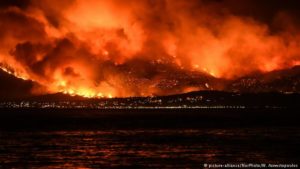
The Earth’s crust sunk 2 cm under the weight of 275 trillion tons of water which flooded Texas during Hurricane Harvey.
A CUNY report suggests that some 500,000 people could leave Puerto Rico following the devastation caused by Hurricane Maria. One month after the hurricane, 80% of the island remains without power, approximately 1/4 of its residents lack access to clean drinking water, and access to medical care is severely curtailed.
“In other words, Puerto Rico will lose the same population in a span of a couple of years after Hurricane Maria, as the island lost during a prior decade of economic stagnation,” says the report.
“Our projections indicate that Florida is the state most likely to be affected by the exodus.”
Folks living in the coastal village of Loiza, Puerto Rico, had already begun adapting to floods from sea level rise in 2016, a full year before the hurricane decimated their infrastructure. Large sections of the town had already fallen in the sea and residents were using milk crates and bricks to hold up their furniture, adding second floors to their concrete homes, and elevating houses on stilts.
Villagers were already frightened, community leader Alexi Correa said last year. “We’re not sure what’s going to happen on a day-to-day basis and not quite sure what is going to happen to our houses or the area if the erosion keeps coming.”
Experts suggest that in a worst-case scenario, hurricanes like Harvey and Maria will intensify due to sea level and become the new normal, occurring every summer in numerous locales.
As the climate warms, the increase in atmospheric energy “drives a more vigorous water cycle: Evaporation rates go up, precipitation rates go up—there’s just more water moving through that cycle faster and more intensely, says University of Utah geochemist Gabriel Bowen. ”
… And then we see many of the agricultural areas of the world—sunny places with marginal water availability—become dust bowls.”
… shifting rains might turn deserts in Africa to green, spurring more intense hurricanes that will eventually hit North America, illuminates the Rube Goldberg connections of the climate system, and proves there may be more than a few surprises in store as the world changes. The Atlantic
Conservative estimates suggest that by 2050, some 300 million people could be displaced from their homes due to climate change impacts. Every second last year, one person was displaced by a natural disaster or an extreme weather event; 24 million people have been uprooted from their homes due to extreme weather anomalies and disasters in the past six years.
 Communities impacted by environmental disasters and change are affected in various manners:
Communities impacted by environmental disasters and change are affected in various manners:
[su_list]
-
[list type=”caret”]
- evacuation
- migration as adaptation
- internal or cross-border movement
- planned or other forms of relocation
[/su_list]
ENDNOTE: Climate Change & Forest Fires

Southern Europe and western parts of Canada and the US have been devastated by wildfires this year. And they’re not the only ones – it seems like much of the world is ablaze right now. And this could be the new normal. http://www.dw.com/en/climate-change-sets-the-world-on-fire/a-40152365
